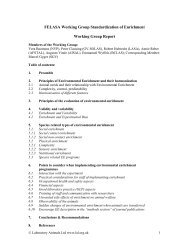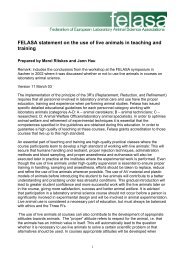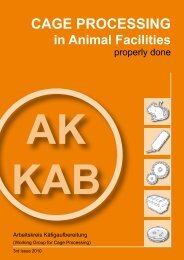CAGE PROCESSING in Animal Facilities - Felasa
CAGE PROCESSING in Animal Facilities - Felasa
CAGE PROCESSING in Animal Facilities - Felasa
- No tags were found...
Create successful ePaper yourself
Turn your PDF publications into a flip-book with our unique Google optimized e-Paper software.
Table 9-6Sources and causesWash<strong>in</strong>g of bottle caps <strong>in</strong> washers designed forcages.Thus can cause clogg<strong>in</strong>g of the bottle nipple due toa carry-over of bedd<strong>in</strong>g particles.Improper usage of detergent or even no use of anydetergent.Overload<strong>in</strong>g of the presentation baskets with bottlecaps.Usage of unsuitable conta<strong>in</strong>ers dur<strong>in</strong>g wash<strong>in</strong>gof caps, for example plastic baskets with smallopen<strong>in</strong>gs which cause an <strong>in</strong>sufficient or even nowater coverage.Preventative measuresTreatment of bottle caps <strong>in</strong> special designedwash<strong>in</strong>g mach<strong>in</strong>e (e.g. bottle and bottle cap washerwith <strong>in</strong>dividual water jet configuration).Usage of adequate detergents (e.g. acid detergent)Avoid clean<strong>in</strong>g of caps <strong>in</strong> a washer after that hasbeen used to process cages with rema<strong>in</strong>s of bedd<strong>in</strong>g.Or: mechanical clean<strong>in</strong>g of the caps only after abasic clean<strong>in</strong>g cycle of the wash<strong>in</strong>g mach<strong>in</strong>e toavoid a carry-over of particles.When clean<strong>in</strong>g caps <strong>in</strong> baskets randomlyaccommodated, the number of caps should belimited <strong>in</strong> order to ensure a complete coverage withwater on the <strong>in</strong>ner side.For a suitable and secure process<strong>in</strong>g of the caps theusage of wire baskets is recommended, to m<strong>in</strong>imizethe spray shadow.For special requirements a particular design ofbaskets is available, with a def<strong>in</strong>ed arrangement ofthe bottle caps enabl<strong>in</strong>g a targeted spot clean<strong>in</strong>g.Rema<strong>in</strong>der of oily, fatty substances – also smallamounts – could lead to partly or fully clogg<strong>in</strong>g ofthe bottle (refer to figure 9.6).Review of quality of the on-site compressed airused for pneumatic decapp<strong>in</strong>g and sterilisation(support<strong>in</strong>g pressure) to avoid oily residues <strong>in</strong> thecompressed air (refer to chapter 5.2.4).Review of compliance of the on-site steam qualityaccord<strong>in</strong>g to steam specification EN 285 (refer tochapter 5.2.2.2) to avoid substances like corrosion<strong>in</strong>hibitors <strong>in</strong> the steam. This would cause an oilylayer <strong>in</strong> the bottle nipple.Review of compliance of the on-site water quality toavoid oily residues <strong>in</strong> the water supply for the bottlefill<strong>in</strong>g procedure (refer to chapter 5.2.1).If applicable evaluate the suitability of the greaseapplied to the door seals of the sterilizer.Figure 9-6 left Cut bottle nipple with <strong>in</strong>adequatewater flow. Clearly visible the <strong>in</strong>complete water wett<strong>in</strong>gon the <strong>in</strong>ner side of the capillaryFigure 9-6 right Cut bottle nipple withtrouble-free water flowCage Process<strong>in</strong>g <strong>in</strong> <strong>Animal</strong> <strong>Facilities</strong> · 4th issue · 2013 65






